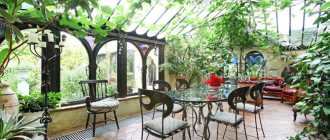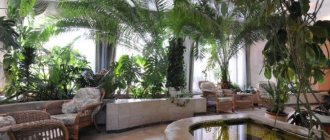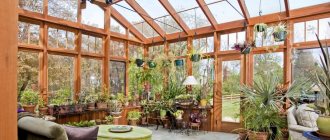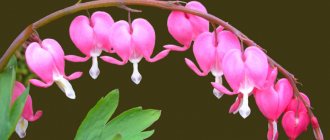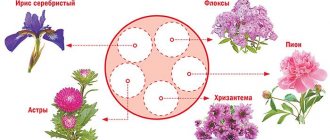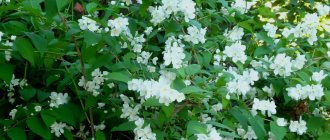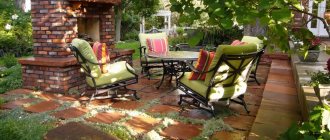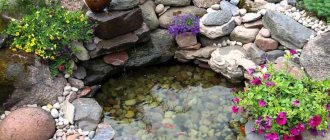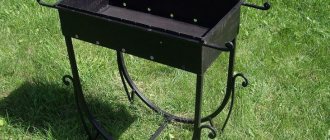Winter garden, its specifics, purpose
A winter garden is a room or structure designed for heat-loving plants. It should not be confused with a greenhouse. These structures are erected for year-round cultivation of flowers and exotic representatives of the flora. Greenhouses are a modification of industrial greenhouses designed for vegetables and herbs. A winter garden in a house, apartment, or reputable office performs other functions. This oasis:
- allows you to admire lush greenery and flowers throughout the year;
- creates excellent conditions for growing rare plants from different continents;
- is an ideal place for relaxation and rest;
- becomes the main decoration of the house.
The winter garden is an ideal place to relax
The winter gardens are equipped with comfortable furniture for a pleasant pastime. Bird cages and aquariums are often placed in the premises, ideally complementing the natural landscape. The climatic conditions of the winter garden are also excellent for fauna; parrots, canaries, tropical fish, etc. feel comfortable here.
Details you shouldn't forget
In conclusion, we will give some tips that may be useful in planning and arranging a home “oasis”:
- calculate the approximate cost of the planned structure;
- determine the location of outlets in advance;
- choose natural materials for furniture (wicker, rattan, wood);
- plan methods and methods of planting;
- take care of fertilizers;
- Shade the garden in hot weather.
A mirror will help to visually enlarge the space of a small room.
History and modernity of winter gardens
There is no exact information about when the winter garden was first equipped. These corners of nature were developed in royal and royal palaces, castles of noble nobles, houses of wealthy merchants, etc. In Rus', the first winter garden was equipped by monks on Solovki. Thanks to their efforts, the Spaso-Preobrazhensky Monastery acquired its own oasis of eternal summer. The monks grew in it not only strange overseas plants, but also vegetables for the monastic diet.
The main condition for maintaining a winter garden is maintaining the optimal temperature required by heat-loving plants. In the first rooms of this kind, a hole was dug into which hot coal was poured. This material smolders for a long time, constantly releasing heat. Stove heating was used to create the required microclimate.
In the winter garden it is necessary to maintain an optimal microclimate
The rapid growth in popularity of winter gardens is due to several factors:
- the formation among city dwellers of an urgent need to communicate with nature, caused by the powerful pressure of the “concrete jungle”;
- the emergence of innovative glazing technology that allows you to create any design;
- Availability of various types of efficient heating systems on the market.
Modern man gets very tired in the city bustle, noise, and abundance of concrete. Outdoor recreation is very popular. But it’s not always possible to go out of town and go on vacation. A winter garden in an apartment or house makes it possible at any time to find yourself in the atmosphere of a tropical jungle, to relax comfortably among lush greenery and flowers.
The winter garden provides an opportunity to escape from the bustle of the city
Today's market provides an opportunity to create excellent conditions for plants anywhere. Reliable panoramic glazing, lightweight, durable metal frames, electric, water, gas heating systems, air humidifiers allow you to create an ideal microclimate. Automation eliminates the need to spend a lot of time and effort on caring for plants.
Greenhouse exterior
If we talk not about the internal contents of the winter garden, but its exterior, then the facade of the greenhouse must, of course, be in harmony with the appearance of the main building, regardless of whether it was originally designed, added after the main construction, or is a separate structure. Most often, the walls of the greenhouse have a base, which is made of brick or stone. Foam blocks or hollow types of brick are rarely used to build a basement - such structures may not withstand the heavy weight of glass walls and a dome or transparent roof.
The basement, decorated with stone in harmony with the design of the main building, looks luxurious. Glass surfaces add airiness to the overall image of the entire building. Even a small greenhouse in this case significantly changes the appearance of the façade of the home.
A similar situation arises with the use of brick as a building or finishing material. Modern facade brick (intended for decorating the facades of houses) can be textured, with fezzes, made in a wide variety of colors.
Types of structures
If a house project with a winter garden is being developed, a special room is allocated for it, in which panoramic glazing is installed to ensure maximum flow of natural light. This creates favorable conditions for plants and allows you to save on the lighting system.
Panoramic glazing will ensure maximum light intake
A winter garden can also be installed in a lived-in country house. It will look like an extension. Aluminum profiles are mostly used to create structural frames. It can be given any shape. The structure can be:
- square,
- rectangular,
- semicircular,
- combined,
- polygonal.
Winter garden in the form of a glazed extension
The choice depends on the specifics and style of the building. The roof can also have any shape. Single- and double-slope options, domes, etc. are used. The best option for a winter garden is full glazing of the structure. This design guarantees maximum sunlight and reduces heating costs.
Choosing lighting
The walls and roof of the winter garden are sheathed with transparent material, which means there should be no problems with lighting. Still, plants often need additional light. There are a large number of sources of artificial lighting: mercury, sodium, fluorescent, LED, metal halide, phyto-lamps and incandescent lamps. Of these, fluorescent ones are the most popular because they save energy, provide excellent illumination and have low heat dissipation.
Phyto-lamps are especially good: they have a positive effect on photosynthesis. The downside of this option is its price.
Think about how you can protect your flowers: curtains, blinds, awnings, awnings
Don’t forget that too much light is also bad.
Materials for creating a winter garden
There are several requirements for these structures. The design should:
• provide reliable protection from the cold;
• create conditions for high-quality lighting;
• have high resistance to external influences;
• have a long operational period.
Structures with a metal frame with an anti-corrosion coating meet these requirements. These can be anodized aluminum profiles, rolled steel, treated with powder dyes. Structures with a large glazing area are provided with the required strength and resistance to loads using metal trusses.
The metal frame is resistant to external influences
Durable, reliable triplex, tempered glass is used to create winter gardens. These materials are highly resistant to stress and safe. It is difficult to break such glass. But if this happens, the risk of injury is eliminated, since the material crumbles into small pieces.
Triplex glass is highly resistant to stress
A winter garden attached to the house can be built from polycarbonate. This material is now very popular. It has several significant advantages:
- high transparency;
- minimum weight;
- low cost;
- resistance to loads;
- durability.
Winter garden made of polycarbonate
Double-glazed windows with metal-plastic, aluminum, and wooden profiles are also used in the creation of structures. The advantages of the systems include ease of installation and reliable protection from the cold. The range of products includes energy-saving, multifunctional glasses.
Requirements for materials for construction
The design of the winter garden must be sustainable, practical and aesthetically attractive. To build just such a building, you need to take a responsible approach to the selection of materials for construction:
You need to select a material that is durable, resistant to rust, with improved performance and a long service life.
One of the most important qualities of a garden material is thermal conductivity. The heat should remain in the finished room for a long time.
The material must withstand the adverse effects of the environment - sun, rain, snow, high and low temperatures.
Natural lighting is one of the main parameters necessary for the harmonious growth and development of plants, therefore the material from which the garden is built must transmit at least 80% of daylight.
Load-bearing structural elements can be constructed from:
- Summer shower at a summer cottage: review of designs, materials, and schemes for self-construction
Do-it-yourself tandoor - a traditional oriental stove in a summer cottage, photos of completed projects
A polycarbonate greenhouse is a joy for a gardener, let’s understand the structures step by step (photo + video)
Aluminum slats. Aluminum is a durable material that is resistant to corrosion and temperature changes.
PVC allows you to bring to life the most daring ideas when creating a room design. This material is light, flexible, easy to process and does not require special care.
Wood is the most popular material for building a winter garden. Wood is most often chosen for the frame of a building because it is affordable and easy to install.
Natural wood must be regularly treated against fungus, insects, and protected from moisture. It is easy to build a garden with your own hands from wood.
Maintaining an optimal climate
In these structures and rooms grow representatives of flora that have special requirements for air temperature. In summer, the glazed structure will ensure natural maintenance of the desired climate. But with the onset of cold weather, additional heating of the room will be required.
Various types of systems can be used in heating. A winter garden in a private house can be equipped with water, electric, gas communications, and solid fuel heating equipment. The choice depends on:
- accessibility, fuel efficiency;
- room size;
- plant species, their temperature requirements.
During the cold season, additional heating is required
In addition to the heating system, the winter garden must be equipped with ventilation that provides access to fresh air, allowing optimal conditions to be maintained. Natural circulation will be ensured by opening windows, transoms, and sashes. Systems with fans will also be required to provide air flow. Tropical plants may require humidifiers.
Opening windows provide natural air circulation
Choosing a form
At the stage of planning a winter garden, it is very important to decide on the optimal form of construction for this room. A separate building can be anything: a sphere, a hemisphere, a cylinder, a cube. However, it is usually rarely installed separately, due to the high price and complexity of implementation.
Most often, a winter garden is part of a living space, in which case its shape also differs. There may be several options:
- a rectangular extension with a pitched roof (the simplest and most popular);
- a structure adjacent to the outer corner of a residential building;
- quarter-polygon (extension to the inner corner of the house);
- structure with a combined roof;
- bay window design;
- L-shaped extension with a gable roof.
Types of structures
Please note: you can design the building the way you need it.
Lighting in the winter garden
It is impossible to provide plants with conditions for good growth and flowering without high-quality lighting. In summer, natural sunlight is sufficient if the greenhouse of the house is equipped with panoramic glazing. But in spring, winter and autumn you will need additional light.
There is no need to create a system with traditional incandescent lamps. These devices consume a lot of electricity and do not provide the blue and red spectrum rays necessary for green growth and flowering. You should not use fluorescent models if voltage surges frequently occur in the network.
Nowadays the lamps most often used in lighting winter gardens are:
- sodium
- metal halide
- LED
Additional light will be required in winter
These devices have high light output and are energy efficient. LEDs and halogen models have a long service life. The best option are special phytolamps designed for plants. They ensure that artificial lighting is as close as possible to the spectrum of sunlight. The development of a lighting network diagram and its installation must be entrusted to qualified craftsmen who have the appropriate license.
The light of phytolamps is as close as possible to the spectrum of sunlight
Basic material for construction
Glass has high transmittance and load-bearing capacity. Almost 100% of sunlight will enter the winter garden.
To decorate a winter garden, you can use any type of glass: colored, impact-resistant, tempered, and so on. Among the disadvantages of the material are its fragility and high cost.
Polycarbonate is a durable and lightweight material that perfectly retains heat in a room. When choosing polycarbonate as the main material for decorating a winter garden, you can save a lot.
Main areas of the winter garden
The winter garden in the house is a place of rest, relaxation, and pleasant pastime. When equipping this important room, you need to ensure maximum convenience for plants and visitors, for care. Each winter garden has three zones:
- recreational,
- communicative,
- decorative
The recreational part houses furniture for comfortable private relaxation, friendly conversations, tea parties, etc. The choice of items depends on the design style. These can be soft sofas and armchairs with leather upholstery, rattan furniture, rocking chairs, etc.
Cozy seating area in the winter garden
A communication zone is necessary for convenient movement around the winter garden, for which passages connecting all areas are equipped.
Plants are located in the decorative part. It can be supplemented with a small pond, decorative bridges, pergolas, sculptures, etc. Aquariums and bird cages are located in this area.
Passages are equipped for convenient movement
Classic style
The most important condition when decorating a room in a classic style is not to overload the interior with details. Moderation is the sister of classics. The walls should be in light colors, and the furniture should be classic and not in flashy colors. Plants look advantageous against a light background. Statues, paintings, frescoes, and lamps would be appropriate. The classical style involves arches, pilasters, columns. But this is not a mandatory condition.
Styles for decorating winter gardens
Often the style that dominates the home is chosen for this oasis to ensure harmony. But this is not a mandatory requirement, especially if it is a winter garden attached to the house. The main criterion is your own idea of a cozy, comfortable place to relax. It is important to focus on your favorite plants that will please the eye.
Any interior style can be used in the design of a winter garden. The most popular destinations are:
- English;
- French;
- Italian;
- Japanese;
- African;
- avant-garde.
It is believed that the first winter gardens appeared in England. Several styles have emerged in this country. All of them are united by aristocracy, a certain laconicism, and elegance. The English style assumes symmetry in the arrangement of interior items and plants, and geometric strict lines. Ideal design elements are antiques and artificially aged furniture. When choosing plants, preference is given to roses, lilacs, euonymus, and weigela. Floors in English conservatories are often covered with black and white tiles. A cozy rug wouldn't go amiss.
Laconic winter garden in English style
French style will appeal to lovers of comfort and luxury. It also has symmetry. In the winter garden, paths with ideal lines are created, the bushes are trimmed evenly. Baroque-style furniture, luxurious ceramic vases, mirrors with carved frames, and garlands of flowers add elegance and chic to the design. Main shades: light green, pink, blue, white, gold. Shrubs, lawn grass, medicinal plants and even vegetables are planted in the winter garden.
Spectacular interior of a winter garden in French style
Design in the Italian format involves the use of a white, sand-colored finish. Low-growing shrubs are trimmed in the shape of balls or diamonds. Flowers with bright buds are planted: daffodils, crocuses, tulips, hyacinths, etc. Water elements must be included, preferably fountains and cascades.
Italian style necessarily includes water elements
In Japanese styles, ideal order reigns and full compliance with the science of Feng Shui is ensured. This direction is characterized by laconicism and spaciousness. The design reflects three elements: air, water, earth. A properly designed Japanese conservatory is the ideal stress reliever. Stones covered with green moss, bonsai trees, flowers with discreet buds in pastel colors will find their place in it.
Japanese style is characterized by laconicism and spaciousness.
Exotic African style is very popular now. In such a garden an abundance of tropical plants, vines, and flowers with large buds is created. The design uses bright colors: yellow, orange, red, brown. Furniture made of rattan and wenge is installed; skins or successful imitations, clay vases, products made from elephant tusk, tortoise shell, etc. are used in the interior.
Exotic African style in the winter garden
It may seem that modern loft or high-tech styles are absolutely not suitable for decorating a winter garden. But designers manage to create spectacular, interesting combinations of metal structures and green spaces and flowers. Such interiors successfully combine the rigor of straight lines and raw surfaces with the gentle charm of flower beds and tropical exoticism.
Winter garden in a modern style
Blog
What is a winter garden?
The winter garden is a garden in the interior.
Therefore, it is an element of phytodesign. If we consider the winter garden from this point of view, then we can understand the difference between a greenhouse, a greenhouse and a winter garden. They differ in 2 points: location and purpose. A greenhouse is a structure made of transparent material (glass, polycarbonate, polyethylene), which is located outside the house, i.e. in the exterior and is intended for growing crops, mainly vegetables. A greenhouse is primarily intended for the convenience of plants, not people.
A greenhouse is similar in appearance to a greenhouse, but is designed to protect plants and flowers from freezing. It can be located as a separate object in the garden or as an extension to the house. A greenhouse is a place where mainly exotic plants are grown. Accordingly, a certain microclimate is maintained there, which is not entirely comfortable for humans.
A winter garden is a full-fledged part of the house, intended exclusively for human convenience. It may look like an extension to the house or be located inside. The appearance of the structure also depends on this: it can be made entirely of glass or partially (walls or ceiling) with a metal or aluminum frame. The plants here are designed to create a cozy and comfortable atmosphere for relaxation, the illusion of summer, when everything outside the window is covered with snow. A large amount of sunlight even in winter, lightness, ephemeral design, the ability to enjoy the feeling of summer all year round among green foliage and rich floral colors are the main reasons why the winter garden is becoming increasingly popular among owners of country houses.
Greenhouse
Greenhouse
Winter Garden
A little history.
The fashion for having a winter garden originated in Ancient Rome. In multi-apartment Roman gardens (insulas), small gardens were grown on wide window sills. Rich Romans - patricians - could afford to plant a garden in courtyards - peristyles. Since flowers were an integral part of religious rituals, they were endowed with symbols. For example, ivy was associated with Dionysus, the god of wine, and myrtle was a symbol of love and the plant of Aphrodite. The heads of the winners were crowned with a laurel wreath. The first greenhouses appeared in the Middle Ages. The fashion for growing exotic plants that bloomed or fruited in winter arose after the hall was decorated with trees and shrubs in full bloom in honor of the arrival of the Dutch King William in Cologne in the winter of 1240. Until now, the greenhouse in Versailles, built during the reign of Louis XIV for growing orange trees, is considered the most beautiful in Europe. At all times, only rich people could afford a winter garden or greenhouse, since all exotic plants were brought from afar and, as a rule, the personnel caring for them were also from the same countries. Today, setting up a winter garden and maintaining its proper appearance also requires considerable costs, just like creating an exterior garden. However, its proper planning at the construction stage will allow you to avoid a number of problems and unnecessary financial costs.
Roman peristyle
Regular Renaissance garden Modern indoor garden
The winter garden is like an extension of the house. Primary requirements.
It is important to understand that a winter garden is not just a collection of plants in a house. This is a whole room that includes a number of systems that ensure the normal development of plants throughout the year. The winter garden can be either inside the house or as an extension, an extension of the living room. In both the first and second cases, you should start by determining the direction of the world. The best directions are east and west. In these cases, the garden will not overheat, and the amount of direct sunlight that can cause burns on the leaves, passing through the glass as through a lens, will be small. Another good thing about the west is that the heat accumulated during the day will remain in the garden until the morning. This is especially important for the winter period. The south is the least suitable for setting up a winter garden, unless you plan to create a real Mexican desert. It will be impossible to be in such a garden in summer without curtains. The north side does not accumulate heat well and releases it quickly, so it is necessary to carefully consider the heating system. The ideal option is when it is possible to locate the garden at the intersection of directions (southeast or southwest). When the cardinal direction is determined, the type of construction is selected. There are a number of requirements that must be met for any type of structure:
- translucency and illumination;
- reliability and resistance to any atmospheric conditions and mechanical damage;
- aesthetic appearance.
Regardless of how much space your winter garden will occupy, its contents must be properly thought out. The main rule that must always be observed when choosing plants is that they must be from the same climate zone. Different plants require different conditions, which are simply impossible to create within one winter garden! Traditionally, the assortment of the winter garden consists of tropical and subtropical beauties. When the choice is made, the technical requirements that must be met during the construction of the garden become clear. So,
- Light. Most plants, especially tropical ones, cannot tolerate direct sunlight in summer. Blinds or roller blinds in light shades are able to transmit enough light, but at the same time create shading. External shading (awnings, awnings) is only relevant for southern regions where there is too much sun. They are capable of blocking 70-90% of sunlight during dangerous midday hours. In winter, the opposite situation arises - a lack of light, especially if the garden is located on the western or northern side. There is a need for additional lighting. Ideally, of course, phytolamps designed specifically for lighting plants are installed. But fluorescent or metal halide lamps will also be quite sufficient during the winter. For 5 sq.m. at a height of 2.5 m, approximately 4 metal halide lamps are needed.
- Temperature. What matters most is the temperature that can be maintained in winter. Tropical aroids (aglaonema, alocasia, anthurium, dieffenbachia, zamiakulkas, monstera, syngonium, spathiphyllum, philodendron, epipremnum), bromeliads (bilbergia, vriesia, guzmania, cryptanthus), arrowroot (arrowroot, calathea, stromanta, ctenanthus) suggest that the temperature will be not lower than 18-24°C. Subtropical palms, ferns, asparagus, ficus tolerate temperatures ranging from 13-18°C in winter. The same applies to evergreen subtropical plants of Japan, China, New Zealand (Japanese aucuba, fatsia, azalea, woodwardia, ophiopogon, araucaria). The same temperature will be optimal for desert plants of Africa and America (cacti and succulents).
The heating system can provide the required temperature:
- air;
- electric;
- oven;
- water
Air heating (heat supply from an adjacent room) is only possible with good thermal insulation of the walls (double or triple glazing) and installation of a fan. However, it should be borne in mind that in this case the temperature in the winter garden will always be an order of magnitude lower than in the adjacent heated room. And if the temperature in the heating system drops, the temperature in the winter garden may drop to unacceptable values. Electric heating using electric fireplaces or air conditioners is more efficient, but quite expensive. A stove heating system, apart from creating a certain color, in general, has no more advantages: the temperature is distributed unevenly, maintaining it is extremely problematic. Water heating is the best option. It provides a relatively constant temperature without sudden changes. Heating radiators are installed around the perimeter of the winter garden and connected to the central heating system of the house. A distribution heat screen installed on the radiators allows you to regulate the thermal regime for individual groups of plants within one room. If the winter garden is an extension to the house, it is necessary to take care of additional insulation of the walls.
- Humidity level. Relevant for tropical and subtropical exotics, the optimal humidity for which is 80%. In an ordinary city apartment, air humidity in summer is 40-50%. In winter, these figures drop to 20-30%. Of course, there are traditional ways to humidify the air around plants: spraying, placing pallets with wet expanded clay or gravel. But all this is unlikely to be suitable for the scale of a winter garden. The simplest and most beautiful way to increase humidity is to install a mini pond or fountain in the winter garden. An alternative option is various air humidifiers equipped with an automatic humidity controller. If the winter garden is small in area and the concentration of plants is high, then you don’t have to worry about additional air humidification: the plants themselves are able to increase humidity through photosynthesis processes. However, in this case there must be a good ventilation and air circulation system.
- Ventilation system. The more plants there are in the winter garden, the more important it is to have a ventilation system. Lack of air circulation provokes the development of dampness and fungal diseases. In summer, natural ventilation using an open window or transom will be sufficient. Its area should be at least a quarter of the area of all the walls of the winter garden. Such dimensions will be able to sufficiently ensure air circulation and saturation with oxygen. The windows can be opened manually or equipped with automation.
Supply and exhaust ventilation is the most economical option for year-round ventilation. At the bottom, along the perimeter of the walls, holes are made for the influx of fresh air, and at the top or on the roof - for outflow, with a fan installed in the hole. If the winter garden is glazed with double-glazed windows, then a valve is installed. A more expensive option is to install an air conditioner that will circulate air. In addition, if desired, an automatic drip irrigation system with soil moisture level sensors can be installed in the winter garden.
Design of plant compositions.
There are several types of designing plants in a winter garden.
- Potted group - plants in pots or flower pots placed next to each other. This is the simplest and fastest type of winter garden layout. Basic layout principles:
- from 4 to 12 pots in one group;
- plants must have similar requirements for living conditions;
- shade-loving ones are located among the more light-loving ones;
- The bulk are decorative deciduous plants. In the foreground or among an array of greenery there are 1-2 pots with flowering plants;
- observance of tiers: taller specimens with dark or large leaves or plants in taller pots are placed in the background;
- in vertical groups the participation of several hanging plants or vines is required. This layout is used to design corners or divide the winter garden into zones.
- The mini-garden is located in one large stationary container, for the construction of which it is better to use natural materials (wood, clay, stone). Good bottom waterproofing and drainage are required. With this kind of winter garden layout, it is important to consider the distance between plants. If they become too dense, a struggle for food and light will begin among them. Therefore, it is advisable to plant each plant in a pot and place it in a common container on a thick layer of drainage (expanded clay, agroperlite, vermiculite, quartz sand, pebbles, crushed stone). The gaps between the pots are filled with peat. Everything is masked from above with loose material. With this method, the risk of fungal diseases affecting all plants at once is significantly reduced, and if necessary, any plant can be quickly removed. The principles of arranging plants are the same as in a potted group, except that more light-loving plants are placed at the edges of the garden, and shade-tolerant ones in the center. The contours of the container are softened with hanging ones (ivy, ficus pumila, tradescantia, hoya, etc.).
- Stringgarden is a new direction in phytodesign of interiors, which can also be used to create winter gardens. The literal translation is “garden on strings.” Plants in pots are suspended from the ceiling. Separately, it is worth mentioning the stringgarden from kokedam. The roots of plants with soil are wrapped in a moss cover, which is securely tied with twine and suspended from the ceiling. Aroids and arrowroots, as well as epiphytes (orchids), are most suitable for this purpose. Some difficulties arise with watering: moss balls are briefly immersed in a container of water, then lightly squeezed and hung again. Plants in hanging gardens feel much better than in ordinary ones, because... The air at a height of several meters from the floor is warmer. Such a garden of artificial or stabilized plants does not require any maintenance.
- A special type of winter garden is a landscape composition , which is an imitation of a natural landscape with miniature paths, ponds and even figures of people, animals, and garden decor.
Winter garden in landscape design.
When we connect the concepts of “winter garden” and “exterior garden”, we first of all look at the winter garden as a transitional link between the house and the garden outside. Thus, the winter garden acts as a relaxation area overlooking the surrounding landscape. Here it is important to provide sliding structures that will transform the closed space of the winter garden into an open one, integrated into the exterior. When planning plant compositions, the same rules apply as when incorporating an exterior garden into the natural world that already exists around the site, when we want the garden not to look like an alien element against the backdrop of tall trees or the shore of a reservoir. Plants that are similar in appearance or the same but varietal variants of surrounding species are selected. Of course, there are certain difficulties here, because... Plants that are not typical for temperate climates are grown in the winter garden. Therefore, the most suitable ones are selected: not palm trees, but citrus fruits, not cacti, but herbaceous ones. In addition to the selection of assortment, the arrangement is also important, taking into account the view from the window of the winter garden. The view from the window is a picture that should have a frame appropriate in style in the form of winter garden plants: for example, solitary symmetrical trees on the sides of the exit from the winter garden, flowering bushes against the background of a monochromatic tree and shrub composition of the exterior, hanging flowerpots.
If there is an exit from the winter garden to the street, it is most advisable to pave the area nearby. Then in the summer it can be turned into a patio, bringing the green inhabitants outside. Some plants (olive, laurel, ficus, fuchsia, begonia, pelargonium, gardenia, yucca, aucuba, azalea, oleander, magnolia, hibiscus) feel great outdoors in summer. They can be included in existing tree and shrub compositions, or used to decorate individual recreation areas.
Mini gardens in mobile containers will be a wonderful decoration for a terrace or patio. The wide range of miniature houses and garden furniture on sale opens up a wealth of design possibilities. The most important rule in creating such kindergartens is maintaining proportions. Therefore, any plants that are small and slow growing are suitable. You need to start building by determining the location and size of the future kindergarten. Once this is determined, the scale is established. Standard doll scale 1:12. It is suitable for designing outdoor miniature gardens. For tabletop compositions, a scale of 1:75 is better suited, according to which the plan is drawn, plants and accessories are selected.
Construction of a winter garden is complex and expensive, just like home improvement, so already at the design stage it is important to take into account all the nuances, so as not to pay extra later. That is why the creation of a winter garden should be carried out by specialists. And then you can enjoy the feeling of fresh air and green foliage all year round. You can find out the price for a winter garden here.
© Katerina Bratanova
- Heading
- Phytointerior design
Selection of plants and accessories for winter gardens
When designing a winter garden in a private house, apartment or office, it is necessary to take into account the type of plants that will grow in it. Representatives of the flora of the tropics and subtropics have different requirements for temperature and humidity. It is not advisable to combine them. If you can maintain a humid, warm climate with a temperature of about 25°C-26°C, you can choose tropical plants for your garden. Representatives of the subtropics do not need such heat. They feel great at temperatures of 20°C-22°C.
Temperature conditions depend on the type of plants in the garden
It’s not so easy to navigate the variety of plants and find the best options for the garden. You can follow the advice of designers designed for decoration in various styles.
If you choose the English version, it should be dominated by greenery. Mandatory elements are hedges and climbing varieties of roses. Large stones and classical sculptures complement the design.
In the English version, greens predominate
In a luxurious French winter garden you can plant ornamental apple trees, honeysuckle, barberry, and thuja. It will be decorated with a variety of flowers and medicinal herbs: wormwood, irises, ferns, sage, lilies, geraniums, lavender, etc. Climbing varieties of roses and stock roses look harmonious in these designs. It is advisable to arrange a small decorative vegetable garden on a high bed.
Climbing roses in the winter garden
A Mediterranean garden may include barberry and juniper, pistachio, thuja and ficus trees, citrus trees and laurel. In such gardens they grow lavender, mahonia, speedwell, periwinkle, etc.
The accents of African design are palm trees, ficus trees, and vines. Hanging plants with bright flowers look great in it. They can be planted in wicker hanging pots, clay vases, etc. Variegated flora will be an excellent option for this winter garden. The garden will be decorated with filamentous Washingtonia, Vriesia, and Zygocactus.
Palm trees are accents of African design
About watering plants
Is your garden small and compact? Then, in order to water all the flowers, you will need a basic watering can, a spray bottle and a schedule for adding water. But in the case of a larger room, watering can become a problem and take a lot of effort and time. An excellent solution is a drip system: pre-installed hoses will ensure a regular flow of liquid into the substrate, and special sensors will be responsible for the humidity level.
For additional humidity and beauty, you can install an artificial pond in the garden.
General recommendations for equipping a winter garden
If you have decided to equip a winter garden in an apartment, or to set aside a balcony or loggia for it in a private house, it is important to make it cozy, beautiful, and create ideal conditions for plants and relaxation. Advice from experienced gardeners will help you achieve this result:
• When decorating a garden, it is advisable to create a three-level composition. It will provide high-quality filling of space. It is necessary to use successful combinations of different shades of greenery, foliage shapes, and shades of flower buds.
A three-level composition will provide a space-filling effect
• You should not limit your choice to garden varieties. The landscape will look more natural if it combines large and small textures, bright and modest representatives of the flora. It is necessary to supplement it with stones, lawn grass, etc.
Natural stones will complement the composition of plants in the winter garden
• It is advisable to build at least a miniature pond in the winter garden. It could be a small fountain, a small pond. Water elements not only perfectly decorate the garden, but are also a source of moisture and participate in maintaining a comfortable microclimate.
The pond will maintain a comfortable microclimate
• Placing all plants and groups along windows is a common mistake. Such placement does not allow creating the most natural atmosphere. Plants and resting areas will become autonomous, completely separate zones.
• Even if the garden is small, it is advisable to find a place in it for a large plant. It will become a successful accent and will advantageously transform the landscape. You can place it in a corner so that the plant does not create a visual division of space.
A large plant will be a good accent
• Vertical gardening will be a good element of the winter garden. It will fit well into any style if you choose the right plant varieties.
Vertical gardening fits well into any style
The choice of furniture for the room must be given special attention. The greenhouse of the house should be made in the same style. It must be taken into account that a humid, warm microclimate will be maintained in the winter garden. The base, frames, and upholstery of products must be durable and practical. Furniture should provide convenience for relaxation and pleasant time with friends and family.
What materials are used for construction
In order for the plants to receive a sufficient amount of sunlight and heat, it is recommended to make the building as light as possible.
The most common materials adapted for this include:
- Glass is durable and transparent, but can crack from a strong impact and is expensive;
- Polycarbonate is moisture resistant, flexible and inexpensive. However, light transmits worse than glass and retains heat poorly;
- Double-glazed windows are quite an expensive material with a lot of weight, but in terms of light transmission and thermal insulation they significantly outperform both glass and polycarbonate;
- Plexiglas is a fairly heavy material, which is often used in combination with other materials for the construction of side walls.
It is recommended to choose material based on the desired results and financial capabilities/
Photo gallery – winter garden
Organization of heating and ventilation
Choosing the right material is half the battle.
In winter, the heat will still not be enough and for this you need to take care of heating:
- Water heating with the connection of the building to the house heating system with the installation of radiators;
- The stove is characterized by uneven heat distribution;
- Split systems
- Warm floor (water or electric);
- UFOs are suitable for small kindergartens;
- Electric heaters.
Another problem worth paying attention to is the ventilation system.
In this case, you will have to choose between natural ventilation, provided by vents, and mechanical ventilation, which is provided by fans.
